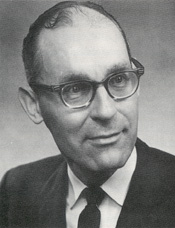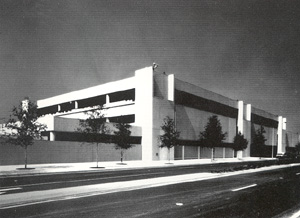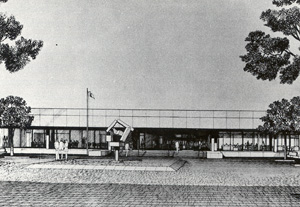Over the first 60 years of the Federal Reserve System, the Sixth District seldom was distinguished outside its own borders. Within the District, nonpar bankers regarded it as an alien agent of creeping federal power. Among the larger, stronger, more progressive banks, however, it was welcomed as an advocate of the region and an important ally in efforts to bring growth and progress. Despite its "federal" affiliation, its causes—better financing for cotton, enlightened agriculture, industrial development, economic diversification, and, of course, sound banking and enlarged credit—were southern causes. Its agricultural economists linked it very directly to the land it served.
But within the System, Atlanta was a chronic also-ran, and position within the System became a matter of regular measurement after the centralization of the Federal Reserve System in 1936. System leadership usually came from other quarters. Malcolm Bryan was regarded as an economic treasure, and, under Neely's prodding, Atlanta had been the second Bank (after New York) to form a professional research department. Neely's push for stronger personnel policies also may have put Atlanta briefly in the vanguard. Yet other Banks quickly followed and passed Atlanta. The gap in salaries compared to other Reserve Banks exacerbated the situation, making it difficult to recruit economists.
The Bank conspicuously lagged in check clearing, partly, as everyone understood, due to the intractable nature of its nonpar constituents. Atlanta, by most of the measures of Reserve Bank success, was running with the pack, somewhat back of the middle, sometimes dead last, and rarely a leader in anything important.
Dramatic turnaround
That situation changed dramatically as the 1970s unfolded. Atlanta frequently was in the vanguard. It became a hotbed of technological experimentation. Improvements of vital importance to the System came to be tried out first in the Sixth District, if not actually invented there. Atlanta shot from a dismal twelfth to a dominating first in the key area of operating efficiency. When banking deregulation in the 1980s led to the explicit pricing of Fed services and threw Reserve Banks into direct competition with correspondent banks and other private-sector vendors, the Atlanta Fed was easily the most successful in recovering its costs and the most vigorous in marketing its services. No other Reserve Bank had the entrepreneurial fervor of Atlanta. One sign of the Bank's success was a new phenomenon: an influx of VIP visitors from other parts of the System, coming to find out how Atlanta was doing it.
Some of the seeds for the revolution were sown by Frank Neely and Malcolm Bryan back in the 1940s and 1950s in their campaign to bring into the Bank bright young men with fresh ideas. Bryan was, of course, a thinker, and while he was not deeply interested in operations and attempted no major reforms in the payments area, he retained his professorial fondness for star pupils. He kept the pot stirred inside the Bank with divergent viewpoints and enforced the policy of recruiting and promoting younger men and giving them clearer assignments and greater authority. A culture for experimentation was forming.
Kimbrel cracks the whip
Much of the revolution in Atlanta occurred during the presidency of Monroe Kimbrel, who, if he didn't plant all of the seeds himself, saw that the crop was harvested.
 Monroe Kimbrel headed the Atlanta Fed from 1968 to 1980. |
Like Max Wellborn, Kimbrel was a southern country banker. Bankers generally had been delighted by his appointment, but his banking ties drew fire from Texas populist Wright Patman, chairman of the House Banking Committee, who called putting Kimbrel in charge of a Reserve Bank "like putting a goose to guard the seed corn."
When Kimbrel became president of the Atlanta Fed he inherited what he regarded as a pretty sloppy operation. Senior officers spent much of their time in meetings where a great deal was discussed but little was done. Under Patterson and in the later years of the Bryan administration the Bank had polarized around several officers, Kimbrel thought, each with his own staff and following and each disappointed that an outsider had been hired for a job that properly should have gone to him. He had to break some bureaucratic patterns, he decided, to make the organization run harder. He wanted to stimulate people to stretch themselves and then reward them when they did. He wanted to see teams working to reach ambitious goals. But he met with resistance, he says, and progress inside the Bank came slowly.
Outside, things went better. He could offer little of Bryan's economic erudition or formal eloquence. But Kimbrel was, and Bryan was not, genuinely fond of mixing with people. Kimbrel was best in small groups or direct conversations. He listened carefully, remembered everything, and took a genuine personal interest in those around him. Bankers still regarded him as one of their own, and business leaders in the District soon were won over by his folksy, unassuming, cheerful attention. The same attitude also was raising morale at the Bank. First as senior vice president, then first vice president, and finally as president, Kimbrel moved easily among the staff, learning everyone's name, finding out his or her interests, inquiring about family members. Not since the days of Eugene Black had the rank and file been treated to so much attention. If popularity could run a Reserve Bank, Kimbrel would have come in first. But there were administrative problems a gracious style could not conquer.
His first major decision was to choose a first vice president, the inside manager who would supervise operations while the president met his considerable outside obligations and provided policy-level direction to the Bank. For the key post he reached over several aspiring senior officers in Atlanta to pick Robert Moody, who was then the manager of the Nashville branch. Moody was a member in good standing of the old guard, respected for his solid knowledge of operations and his hard work.
His appointment proved to be an unfortunate choice, however, due to circumstances beyond anyone's control. Moody suffered a debilitating stroke in the spring of 1968, several months after his move to Atlanta. The stroke was not so serious as to rule out Moody's recovery, and he did return to the Bank in the fall and struggled to resume his duties, but he simply wasn't able to do so. By 1969, it became apparent that the Bank would need another first vice president. During this first year of Kimbrel's presidency, progress in reorganizing and invigorating the Bank was slow. Kimbrel had to endure some needling from Washington and the other District Bank presidents. "If there were 13 banks, you'd be 13th," he was assured.
Assembling a winning team
About this time, examiners from Washington were in the Atlanta Bank for their annual inspection, so Kimbrel called the head examiner into his office and asked him where in the Federal Reserve System he could find a tough and able chief administrative officer. Several days later the examiner called to give him the name of Kyle Fossum. Fossum was a senior vice president of the Minneapolis Fed. He had managed a branch in Helena, Montana, and understood branch administration. He was active on System committees and knew the Atlanta Fed's reputation as a struggling Bank. Atlanta was not a prestigious assignment, but a first vice presidency was a promotion that seemed remote in Minneapolis, and Fossum liked what Kimbrel was telling him about his plans for the Bank. Fossum, then 50, would retire in another 10 years. The challenge and the move South looked right to him, so he took the post. Moody became senior vice president and retired at the end of the year.
Fossum slid smoothly into the Atlanta Bank's management in 1969. He was outside the established circles but enough of a seasoned operations pro to be respected by the old guard, and he was in step with Kimbrel's plan to shake up the Bank and make it run better. Kimbrel made another staffing decision with far-reaching implications that same year when he hired Robert P. Forrestal as general counsel. Forrestal, then at the Board of Governors, would one day become president of the Bank. With a leadership team finally in place, results soon became noticeable.
Kimbrel kept up the campaign to give able young officers positions of growing importance. One veteran senior officer of that period, Billy Hargett, recalls being asked by Kimbrel in 1969 to recommend an Atlanta officer to manage the Birmingham branch. Kimbrel told Hargett what kind of person he wanted. Hargett conferred with several other senior officers over the Birmingham appointment and came back to Kimbrel to recommend a seasoned member of the Atlanta staff. Kimbrel was exasperated. If that's the only name you can bring to me, he said, you weren't listening to what I asked for. He repeated his instructions, and the officers conferred again and came back with a second name. "That's more like it," Hargett remembers Kimbrel saying. The man whom they overlooked the first time as too young and inexperienced was 31 year-old Dan Hendley, who had been with the Bank seven years. Hendley did so well in Birmingham that he was hired away in 1973 by Alabama Bancorporation (now AmSouth); by 1983 he was president and chief operating officer of that bank.
Management also passed into younger hands at the New Orleans Branch in 1968, when Arthur Kantner replaced Morgan Shaw. Although he was trained as an agricultural economist at Cornell University and spent many years in research, Kantner already had proved his skill in managing operations as assistant cashier in Atlanta. As head of the New Orleans operation he reflected not only Kimbrel's drive for efficiency but also his amicable style. In New Orleans Kantner automated cash processing and built morale by circulating among all employees. One day his "management by walking around" brought him to the mechanical equipment room on the roof level of the building. From there he decided to walk out onto the roof for a look around, but unfortunately the door blew shut and locked behind him. He was trapped on the roof for a long while, his shouts to the street below proving to no avail. Finally, Kantner resourcefully folded a document in his pocket into a paper airplane and sailed it from atop the building to the parking lot below. His missile attracted the attention of a passerby who called Kantner's plight to the attention of Bank guards. Kantner went on to become the Bank's first executive vice president in 1982, a position from which he provided transitional support during the changeover from William F. Ford's to Forrestal's administration. He then retired at the end of 1983.
 Rapid economic growth in Florida during the 1970s and 1980s necessitated the construction of a new branch building in Jacksonville. |
Expansion in Miami
Finding leadership for Birmingham and New Orleans was simpler than providing capacity for the burgeoning load of business that was building in Florida. Branching effectively ended in the Federal Reserve System with the Charlotte branch (of the Richmond Fed) in 1928. Since then, improved transportation generally had reduced the need for dispersed offices, but Florida was a special case. Phenomenal growth between 1914 and 1969 had transformed the state and made Miami a busy banking center. The Jacksonville branch, 350 miles north of Miami, was hard pressed to serve so large a zone. Therefore, in 1970 the Atlanta board voted to build a check collection and coin and currency center in Miami as soon as possible, and then to expand it to a full branch.
By August 1971 the Miami office was in business with a staff of 164, including many experienced officers on loan from other Sixth District offices. By the summer of 1975 it was not only a full branch but the District's busiest in handling coin and currency.
The Miami branch quickly outgrew its original building, and much attention was given from 1976 to 1978 to the construction of a $13.4 million facility. The choice of a suburban location proved controversial, however, and ground breaking had to be delayed for several months when Miami business leaders, disappointed that the Bank had chosen a site outside the city, petitioned the Board of Governors to rule in favor of a downtown site instead. The Board denied this request, and the staff moved into the new building in the summer of 1980 and dedicated the state-of-the-art complex that September.
Later in the 1980s Florida's economic growth would once more strain the capacity of the Jacksonville facility as well. In September 1987 newly appointed Fed Chairman Alan Greenspan helped to dedicate the $22.3 million, 200,000-square-foot branch building at 800 Water Street, not far from the 90,000-square-foot office on Julia Street where the branch operated for 34 years.
 The Atlanta Fed's Miami branch. Miami was the most recent city to open a branch in the Federal Reserve System. |
Sources of economies
The campaign by Kimbrel and Fossum to raise the operating efficiency scores of the Bank got a boost from unexpected quarters outside the management of the Bank. A lower pay scale and less expensive Burroughs operating systems gave the Sixth District lower operating costs than other Federal Reserve Banks. Far more important was the growth of the District economy. The Bank's rise to operating prowess coincided with the rise of the "Sun Belt" economy. The Kimbrel years at the Atlanta Fed were years of economic turbulence—a wage-price freeze, bursts of runaway inflation, a couple of sharp recessions, an oil embargo, and an energy crisis—but they were years when the Sixth District economy was one of the strongest in the country. It was matched only by Dallas, prior to 1986, and then falling oil prices sent the economy of the Dallas District into a tailspin.
This Sun Belt revival enlarged the labor pool from which the Atlanta Bank drew its staff. More important, it swelled the volume of transactions which coursed through the Bank, and more transactions made higher efficiency possible. By late 1973, Fossum could report that over the first 10 months of the year, the Bank had cleared more than a billion checks (1,092 million), second only to Chicago.
Also helpful was the final demise of nonpar banking. State laws finally ended the practice in Florida in 1969, in Georgia and Mississippi in 1970, in Tennessee in 1971, and in Alabama in 1972. A handful of Louisiana banks persisted in nonpar check clearing until 1980. There were still 201 nonpar banks in Georgia when Kimbrel and Moody went over to the state capital to watch the signing of the Georgia law that would end the practice. With each par clearing statute, the volume of checks processed by the Atlanta Fed rose.
| Previous | Next |



